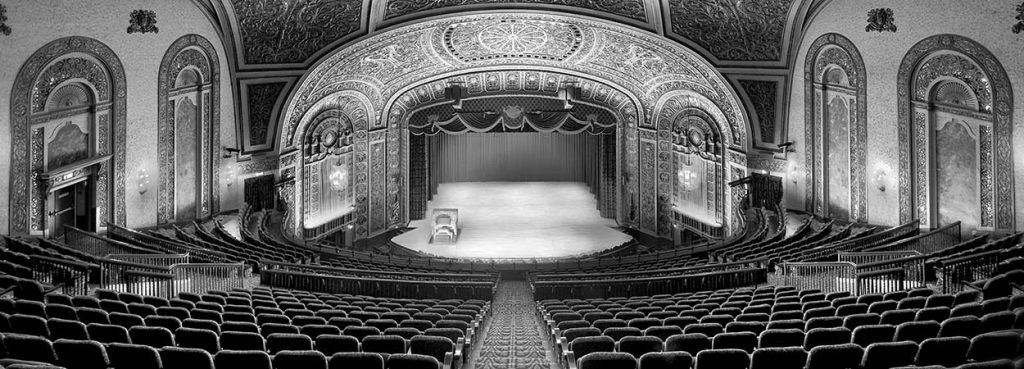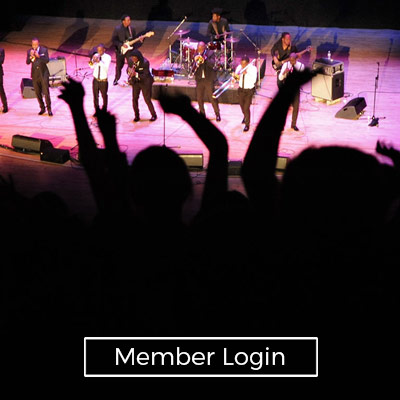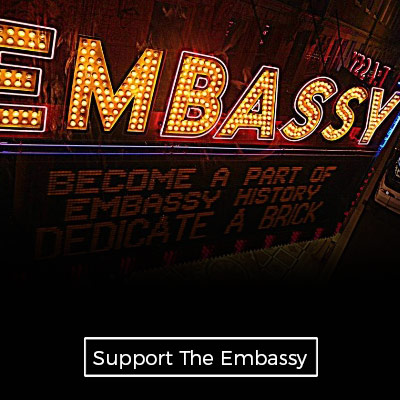On May 14, 1928, the doors of the magnificent Emboyd Theatre opened in Fort Wayne, Indiana. Built as a movie palace and vaudeville house, the Emboyd provided a majestic backdrop for the entertainment of the day, complete with a Page theatre pipe organ. The Emboyd came complete with the seven-story, 250-room Indiana Hotel wrapped around the north and west sides of the theatre. Clyde Quimby, theater operator, had commissioned A.M. Strauss and John Eberson to design the Emboyd and the Indiana Hotel.
Vaudeville was at its height of popularity and the Emboyd featured acrobats, comedians, magicians and musicians. For nearly 25 years the biggest and brightest stars of stage and screen graced the Emboyd stage: Perry Como; Lawrence Welk; Louis Armstrong; Tony Bennett; Chico Marx; Doris Day; Duke Ellington; Cab Calloway; Donald O’Connor; Marilyn Maxwell; Red Skelton; Victor Borge; and Artie Shaw were perennial favorites. Bob Hope’s first emcee job was at the Emboyd. Over time, television and “talkies” slowly eroded the popularity of silent films and vaudeville acts, the mainstay of the Emboyd. In 1952, the Emboyd Theatre and Indiana Hotel were sold to the Alliance Amusement Corporation. The name changed to the Embassy Theatre.
After the sale, the Embassy continued to operate as a movie palace. During this time, the theatre pipe organ, lovingly nicknamed Miss Page, was rarely used. A small group of organ enthusiasts came together to become the unofficial guardians of the organ and its home, the Embassy Theatre. Buddy Nolan was one of these guardians.
With stints playing piano at local restaurants and also employed as house organist at the Embassy in the 1950s and 1960s, Buddy and his friends continued to maintain and restore the organ, often with money from their own pockets. In 1963, Nolan played the first concert on the Embassy’s restored Grande Page Pipe Organ from midnight to 2:30 a.m., beginning the tradition of Nolan’s famed Theatre Organ at Midnight concerts. Despite the late hour, Nolan’s concerts were a tourist attraction for theatre organ lovers from neighboring states.
During this time, the Embassy Theatre and the Grande Page held on while other theatres in downtown Fort Wayne succumbed to destruction. Times were changing and the Indiana Hotel was closed in 1971.
Faced with the wrecking ball in 1972, a handful of community leaders and volunteers, led by Robert Goldstine, banded together to form the Embassy Theatre Foundation. Their goal was to protect the building for the good of the community and preserve the home of the Grande Page Pipe Organ. Through the efforts of these volunteers and the support of a caring community, the successful “Save the Embassy” campaign raised the $250,000 necessary to rescue the building from demolition with just two days to spare.
After the building was saved, the work really began. Volunteers, including Donald Fox, Ray Danford, Chuck Wyss, Byron Fogt, Ellsworth Smith, Bob Nickerson, Bill Zabel, Ron Cayot, Becky Sumpter and countless others kept the Embassy alive by feeding coal bought with their own money into furnaces to keep the pipes from freezing. Efforts to fix the leaking roof and clean coal dust from the terra-cotta walls and lobbies continued. Buddy Nolan, Bob Goldstine and Dyne Pfeffenberger spearheaded the political and philanthropic efforts to create a long-term plan for the operation of Fort Wayne’s treasured historic theatre.
In May 1975, Buddy Nolan played another of his famous organ concerts as an Embassy fund-raiser and filled the house to capacity. Later that year the Embassy was placed on the National Register of Historic Places. With the re-opening of the theatre, stars began appearing on the Embassy stage once again.
In 1985, the Embassadors, the former name for Embassy volunteers, established the first Festival of Trees, which grew out of a recommendation from Barbara Wigham. The initial festival raised $46,000, which was used to restore and renovate the front lobby entrances.The tradition of the Embassy Festival of Trees continues to this day with nearly 15,000 attendees annually.
In 1995, a major renovation of the Embassy included expanding the stage to bring the theatre up to the modern standards required by large-scale touring companies. The theatre seats were upgraded, creating a seating capacity of 2,471. The renovation also included a facelift for the Indiana Hotel lobby and mezzanine, allowing the space to be used for social events. The renovation restored the stage and hotel to its former grandeur, once again making the Embassy the showplace of northern Indiana.
In 2003, the Embassy dedicated its Walk of Recognition, created to honor the stars that called northeast Indiana home.
Perhaps the most visible renovation project in 2005 was the installation of the new Embassy marquee. Built by Wagner Sign Company in Ohio, the marquee features the well-known design of the 1952 marquee, with lighting components and restored infrastructure. The restored marquee features digital reader boards allowing for show information and messages to be changed rapidly with a computer.
Another addition to the building is the vertical blade sign. Reminiscent of the original vertical blade sign on the theatre when it opened in 1928, the new blade sign reads “EMBASSY.” At the same time as the marquee and vertical blade installation, the Embassy added the Indiana Hotel canopy. Similar to the 1928 canopies along the building’s Harrison Street and Jefferson Boulevard facades, the lighted structure provides better visibility for the building and serves as an alternate entrance for Embassy Theatre patrons during inclement weather.
In 2005-06, Embassy Theatre projects included the renovation and expansion of the ladies lower-level lounge, purchase of new furniture and upgrading of all remaining restrooms.
The historic Embassy Theatre features national productions from the Broadway stage, concerts of all musical formats, cinema, educational programming and a continued commitment to young people. The Embassy and adjoining Indiana Hotel play host to a myriad of professional, social and community events each year. From the annual Festival of Trees to corporate functions and weddings, the Embassy and Indiana Hotel are the perfect backdrops for every event.
Constant preservation and restoration work, renovation, fund-raising and countless hours of work from generous volunteers and staff go toward keeping the Embassy not just alive, but growing, teaching, entertaining and inspiring.
Through all renovations and improvements, the Embassy Theatre has maintained the historic integrity of the building that is on the National Register of Historic Places.




